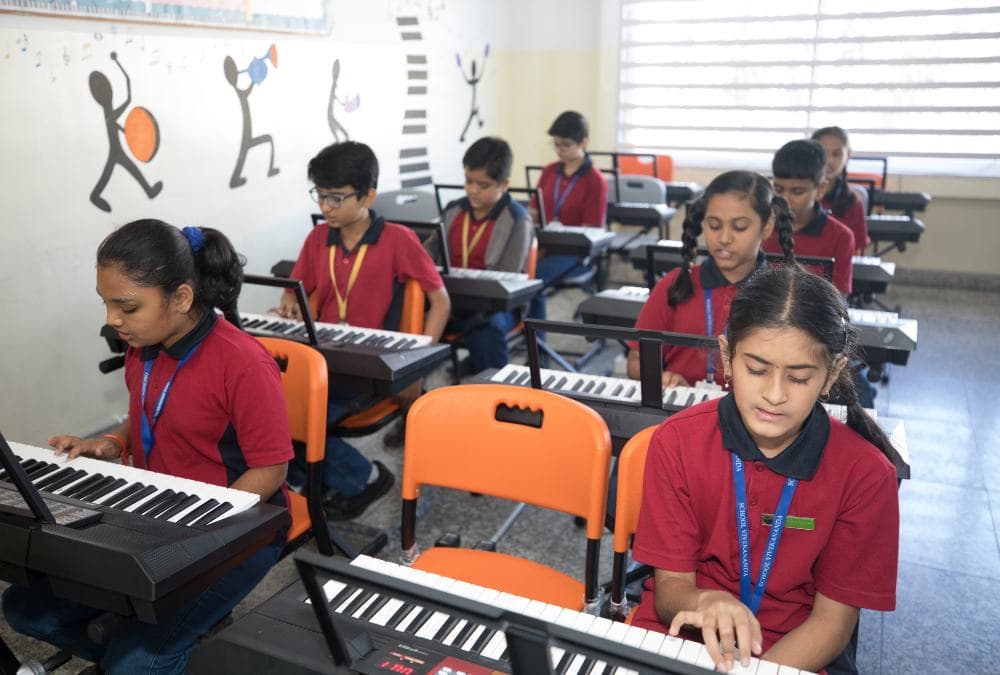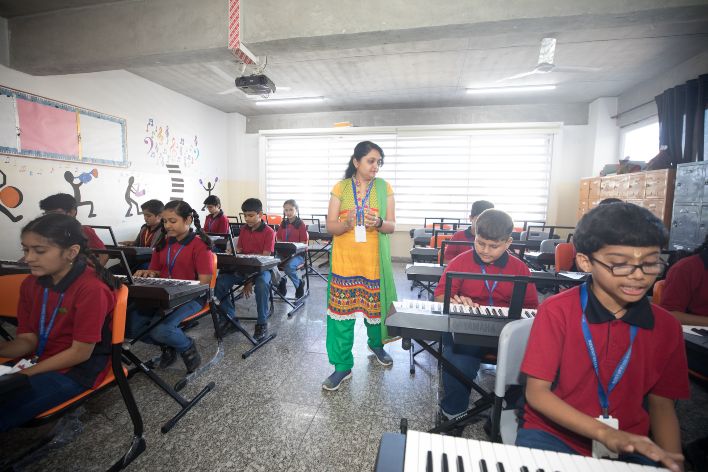How Does Music Help in Language Development in Children?
By Pinkey Sharma |
Date 08-08-2024

Table of Contents
- The Relationship between Music and Language
- Music and Language Development in Early Childhood
- How to Understand Music Theory
- How Guitar Music Is Understood
- Helpful Hints for Parents and Teachers
- Understanding Music Theory: A Deeper Look
- Music in the Language Learning Curriculum
- Conclusion
- Frequently asked questions:
Admissions Open for
Music is the universal language that can be understood by all, whether it is cultural or linguistically diversified people. Music has much to do in human development, especially in children. Not only that, but it also exerts a deeper influence on the child's language development. The blog explains how music contributes to language development in children at a tender age. The content explains how to understand music theory which helps in language development in children.
The Relationship between Music and Language
Language and music do share some similarities. Both possess rhythm, pitch, and timbre and are also processed within partially overlapping areas of the brain. From this, it can be derived that music would have a profound effect on the development of language. It is discovered that musical training can influence in different abilities of language processing, including phonological awareness, vocabulary acquisition, and syntax understanding.
Music and Language Development in Early Childhood
Early childhood is the most ideal time for language learning. At this age, the children's brains have been most flexible to alter their neural route due to experiences that would affect it. Therefore, introducing music in the early years can be an enriched auditory environment for language development.
Linguistic Awareness
Linguistic awareness refers to the ability of a person to identify and be able to manipulate the words of spoken language. This is very essential in developing reading and writing skills. Music, as associated with singing and rhyming activities, can enhance linguistic awareness. Songs usually segment the language into smaller sound units which help children produce and hear the sounds more accurately.
Vocabulary Acquisition
This may further aid in vocabulary development. Songs are an excellent source for introducing children to new words and their meanings in a more fun and easy way. Repetition—one of the characteristics of music—helps in reinforcing these new words inside the children's memory. What is more, the emotional and social context of music might make learning new vocabulary very meaningful and memorable.
Syntax and Grammar
The complexities of the structure of language consist of syntax and grammar. Structures and patterns within music often parallel grammatical syntax. For instance, the taking of a melody on a musical instrument or singing involves knowledge of sequences and rules of construction similar to constructing sentences in language. By doing so, children may develop a better feel for language syntax and grammar.

How to Understand Music Theory
Understanding music theory is, therefore, very important in understanding how music influences language development. The music theory offers a window into all aspects of music: rhythm, melody, harmony, and form. Thus, learning music theory helps one have a deeper appreciation for music and its connection to language.
Basic Elements of Music Theory
1. Rhythm: Rhythm is a pattern of sounds and their silences, which is the very fundamental basis that language shares because it deals with timing and thus arrangement of sounds.
2. Melody: A melody simply defines as a succession of pitches that, taken together, form a musical phrase. This might be thought of comparably as the melody-like patterns of speech tone in language.
3. Harmony: Harmony is the combining of different pitches that are played/sung simultaneously. The understanding of harmony contributes to appreciation of the complexity of both music and language.
4. Form: Form is the overall structure of a composition. Language also has structures and patterns for children to learn how to understand and use.
How Guitar Music Is Understood
Musical instruments like guitar, can further improve language development. The fact that a guitar can be used for any style and is therefore universal makes it good for a child to learn how to play it.
How Learning Guitar Benefits Language Development
1. Precision skills: The guitar requires finger movement and hence leads to the development of precision. These are precisely the skills called upon while one writes or accomplishes many other language-based tasks.
2. Hearing Discrimination: Some sources state that playing the guitar improves one's hearing discrimination. Hearing discrimination is the process by which a person hears and can distinguish different sounds. This in a way, is relevant to the development of language. This is so because children need to hear the sounds of speech and reproduce them.
3. Memory and Concentration: When playing the guitar, one has to memorize chords, melodies, and rhythms. These develop memory and concentration, two important factors in picking up a language well and in using it effectively.
4. Emotional Expression: Music is a means to express feelings and consequently aids in social/emotional development. Similarly, sometimes, the ability to express emotions through music can facilitate better communication in language.
Helpful Hints for Parents and Teachers
In fact, parents and teachers themselves can do much to help children grow in the use of language through music. The following are some useful tips:
1. Impregnate Music into the Daily Routine: Help make routine activities at bath time or bedtime more enjoyable by using songs that assist in language skills development with your child.
2. Musical instruments: Provide them with musical instruments like drums, shakers and guitars. Show them how to play and ask the children to experiment with the sound an instrument can create as they play it and make their own music.
3. Music Classes: The children could be enrolled in some music class where they may get training with the basics of music to practice the same through instruments. Group music activities also help in social development.
4. Singing and Dancing: The ability to sing and dance to the beats will develop in the child a sense of rhythm and coordination. Important precursors for language development.|
5. Musical Environment: The home environment should provide a broad range of music to be played, hence exposing the children to different styles of music and cultures, broadening their auditory experiences and enhancing language learning involvement.
Understanding Music Theory: A Deeper Look
Understanding the basics of music will give them the keys to appreciating and creating music, therefore enhancing their language development. The key musical theoretical concepts with bearings on language learning are:
Scales and Intervals
Scales are series of notes lined up in exactly the same pattern of intervals. In learning scales, children learn pitch and melody, a capacity useful in music and language. Intervals—the distance between two notes—also help children develop a sense of pitch and tune their ears to the sounds of language.
Chords and Harmony
Chords are groups of notes strummed or picked simultaneously to achieve harmony. Students will be able to understand chords and harmony and develop an overall appreciation for the structure and complexity of music as well as language. For example, the construction of chords from specific intervals is comparable to the way sentences are constructed from words using those words according to certain grammatical rules.
Rhythm and Meter
Rhythm is the pattern of music beats, and meter refers to an organization of those beats into measures. Understanding rhythm and meter will help children in developing their timing and flow in music and speech. That enables more production and comprehension of fluent, rhythmic speech.
Case Studies and Research
According to a number of studies, music helps children in language development. According to one of the researches published in "Frontiers in Psychology," children undergoing music training showed improvements in phonological awareness, vocabulary, and syntax, unlike others. A study published in another journal, "The Journal of Neuroscience," shows that musical training could increase the brain's ability for processing speech sounds, an essential ability in language development.

Music in the Language Learning Curriculum
Music-Based Curriculum
Some language learning curriculum have already adopted the use of music. For example, the Kodály Method by Hungarian composer Zoltán Kodály applies folk songs and musical games to teach language and literacy skills for children. It focuses on developing the children's sense of listening, singing, and movement to learn the language.
Technology and Music Apps
Coupling music with language now comes easily with plenty of apps and online resources at hand in the digital age. This makes learning much more engaging for a child. For example, applications teaching languages through songs and games of rhythm can be most helpful in letting children remember new vocabulary and grammar structures playfully.
Understanding Music Theory: A Deeper Dive
Understanding music theory provides children with the equipment to appreciate and create music, enhancing their language development further. Here are some aspects of music theory most relevant to language learning.
Scales and Intervals
Scales are sequences of notes that proceed in a particular pattern of intervals. Understanding scales is significant in the learning process for pitch, melody, and language in general. Intervals—the space between two notes—can help a child develop a sense of pitch and tune his ears to the sounds of language.
Chords and Harmony
Chords are groups of notes that are strummed or played all at the same time, thus producing harmony. The study of chords and harmony makes it possible for a child to appreciate the structure, even the complexity, of music as well as language. For instance, chords are constructed from specific intervals just like sentences can be formed from words that follow grammatical rules.
Rhythm and Meter
Rhythm refers to the pattern of beats, whereas meter refers to their grouping into measures. To that effect, this sensitivity to rhythm and meter helps give the child a sense of timing and flow in music and speech—a virtue invaluable in the production and comprehension of fluent, rhythmic speech.
Conclusion
Music is, therefore, an immensely powerful tool in supporting language development in children. Through the understanding of music theory and by musical participation, children can develop crucial language skills in phonological awareness, vocabulary acquisition, and syntax understanding. Instrumental instruction, as playing the guitar, provides additional benefits. Parents and teachers may support this process by setting up music in the daily routine with the help of musical instruments and music classes and by encouraging singing and dancing in a family environment.
The relationship between music and language is deep and multi-dimensional. Thus, by guiding children to appreciate music and offering them ample opportunities to engage in making music, we are giving them a lifelong love of language and the basic competencies at school and beyond. Let us embrace music for its power and potential to transform language learning for our children.
Frequently asked questions:
How can music help learn a language?
Music improves a child’s pronunciation and tone. While the music is being played children may recite the music along with the singer which can help in language development.
How does music influence language?
The children when they listen to music listen to the words of the music, which can help children understand the words and can influence language.
How is music used in language teaching?
Listening to music improves the grasping ability of the children and children can recite new words. This can help in language teaching amongst children.
How does music help a child’s language development?
Songs and nursery rhymes help children introduce new words and phrases amongst the children. Thus children can learn the language and can start speaking early.
Did language develop from music?
Some researchers believe that language was developed from music. The connection between language and music is deep.
How can music be used as a teaching method?
The nursery rhymes are the ones that are learned by the children through listening to music. Also, the alphabets are taught in schools to the children in musical tones.
Share your music experience in development in the comment section below!
Liked what you read? Feel free to share this article with your friends and spread the knowledge!
Related Blogs
Importance of Arts for children: Learn why arts education is essential for children.
Best Ways to practice music for kids: Discover the top methods for kids to practice music.
Importance of Music for Kids: Uncover the crucial role of music in children's development.
CBSE Schools In Popular Cities
- CBSE Schools in Bangalore
- CBSE Schools in Mumbai
- CBSE Schools in Pune
- CBSE Schools in Hyderabad
- CBSE Schools in Chennai
- CBSE Schools in Gurgaon
- CBSE Schools in Kolkata
- CBSE Schools in Indore
- CBSE Schools in Sonipat
- CBSE Schools in Delhi
- CBSE Schools in Rohtak
- CBSE Schools in Bhopal
- CBSE Schools in Aurangabad
- CBSE Schools in Jabalpur
- CBSE Schools in Jaipur
- CBSE Schools in Jodhpur
- CBSE Schools in Nagpur
- CBSE Schools in Ahmednagar
- CBSE School In Tumkur

Call Us to know more about Orchids
Swipe Up

.jpg&w=1920&q=80)














